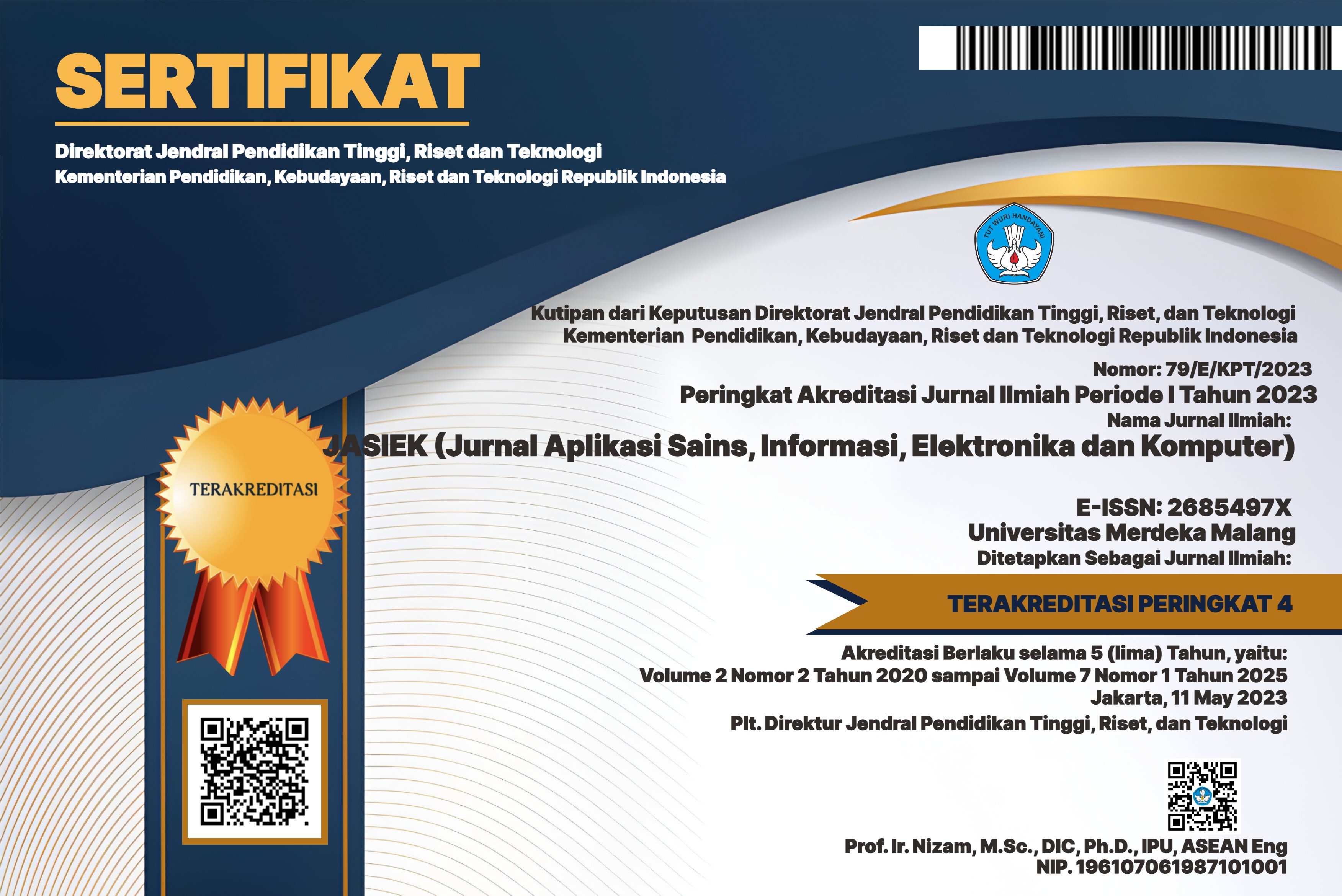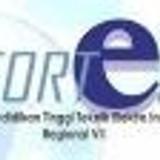Sistem Distribusi Air Bersih Berbasis IoT dengan ESP8266 dan RTC untuk Optimalisasi Waktu Pengaliran
DOI:
https://doi.org/10.26905/jasiek.v7i1.15264Keywords:
Distribusi Air Bersih, Internet of Things (IoT), ESP8266, Real-Time Clock (RTC), Monitoring Jarak Jauh, Sistem Otomatisasi, Efisiensi Pengelolaan AirAbstract
Efficient clean water distribution is essential to meet the needs of communities in various regions. This study aims to develop an Internet of Things (IoT)-based clean water distribution system using ESP8266 as the main controller for automatic and scheduled water flow timing. This system is able to regulate the opening and closing of taps on a schedule and allows manual control via mobile phone devices. The method used includes the integration of IoT technology with the Blynk application for real-time monitoring and control. The results of the study show that this system can optimize the use of water resources, reduce waste, and ensure a more regular distribution of clean water. In addition, the flexibility of control via mobile phones makes it easy for users to manage water distribution. This study offers an innovative solution that can be applied to improve the efficiency of clean water distribution in various regions
Downloads
References
[1] S. P. Makin, N. Nachrowie, and S. Subairi, “Penerapan Metode Fuzzy Sugeno pada Otomatisasi Oven Pengering Ikan Asin Berbasis IoT,” Blend Sains Jurnal Teknik, vol. 2, no. 3, pp. 244–255, 2024.
[2] R. A. Mouha, “Internet of Things (IoT),” Journal of Data Analysis and Information Processing, vol. 09, no. 02, pp. 77–101, Apr. 2021, doi: 10.4236/JDAIP.2021.92006.
[3] M. A. Baihaqi et al., “Analisis Integrasi IoT pada Sistem Pembangkit Hybrid Portabel Pico Hidro dan Panel Surya,” Jurnal Aplikasi Sains, Informasi, Elektronika dan Komputer, vol. 6, no. 2, 2024.
[4] A. Bachri, A. B. Laksono, and A. M. Abdillah, “Rancang Bangun Smart Inverter dan ATS Tenaga Panel Surya Berbasis Internet of Things (IoT),” JASIEK (Jurnal Aplikasi Sains, Informasi, Elektronika dan Komputer), vol. 6, no. 1, pp. 23–32, Jun. 2024, doi: 10.26905/jasiek.v6i1.11169.
[5] A. Rayes and S. Salam, “The Things in IoT: Sensors and Actuators,” Internet of Things from Hype to Reality, pp. 63–82, 2022, doi: 10.1007/978-3-030-90158-5_3.
[6] M. Wijayanti, “Prototype Smart Home dengan NodeMCU ESP8266 Berbasis IoT,” Jurnal Ilmiah Teknik, vol. 1, no. 2, pp. 101–107, May 2022, doi: 10.56127/JUIT.V1I2.169.
[7] B. Ajiwicaksana, A. R. Pangestu, and M. Nurhandi, “Pengembangan Sistem Penyiraman Otomatis berbasis IoT,” Jurnal Penelitian Ilmu Komputer, vol. 1, no. 2, pp. 1–9, Dec. 2023, Accessed: Jan. 29, 2025. [Online]. Available: https://jpilkom.org/index.php/journal/article/view/22
[8] A. T. Wahyudi, Y. W. Hutama, M. Bakri, and S. D. Rizkiono, “Sistem Otomatis Pemberian Air Minum pada Ayam Pedaging Menggunakan Mikrokontroller Arduino Dan RTC DS1302,” Jurnal Teknik dan Sistem Komputer, vol. 1, no. 1, pp. 15–21, Jun. 2020, doi: 10.33365/jtikom.v1i1.71.
[9] G. P. Pereira and M. Z. Chaari, “Comparison of Blynk IoT and ESP Rainmaker on ESP32 as Beginner-Friendly IoT Solutions,” Lecture Notes in Computer Science (including subseries Lecture Notes in Artificial Intelligence and Lecture Notes in Bioinformatics), vol. 13735 LNCS, pp. 123–132, 2023, doi: 10.1007/978-3-031-23582-5_9.
[10] Efrizon, M. Irmansyah, A. Nasution, E. Madona, and A. L. Rani, “Sistem Pendistribusian Air Bersih Metode Prabayar Terkendali Mikrokontroler Berbasis IoT,” Jurnal RESTI (Rekayasa Sistem dan Teknologi Informasi), vol. 5, no. 6, pp. 1025–1035, Dec. 2021, doi: 10.29207/RESTI.V5I6.3485.
[11] H. Sujadi, A. Mardiana, and A. Permana, “Pengembangan Purwarupa Monitoring Tagihan Air PDAM Berbasis Internet of Things,” INFOTECH journal, vol. 7, no. 2, pp. 9–14, Aug. 2021, doi: 10.31949/INFOTECH.V7I2.1251.
[12] Sulistiyanto and Moh. Jahrudy, “Internet of Thing untuk Control dan Monitoring Air pada Pelanggan PDAM,” Informatech: Jurnal Ilmiah Informatika dan Komputer, vol. 1, no. 1, pp. 47–51, Jul. 2024, doi: 10.69533/B6NYRB07.
[13] Galis Asmara, “Peluang dan Tantangan Pengendalian Kehilangan Air Berbasis Internet of Things (IoT) : Studi Pustaka The Opportunities and Challenges of Water Losses Control Based on Internet of Things (IoT) : Literature Review,” Jukung Jurnal Teknik Lingkungan, vol. 7, no. 2, 2021.
Downloads
Published
Issue
Section
License
Copyright (c) 2025 JASIEK (Jurnal Aplikasi Sains, Informasi, Elektronika dan Komputer)

This work is licensed under a Creative Commons Attribution-NonCommercial-ShareAlike 4.0 International License.
Authors who publish with this journal agree to the following terms:
The journal allow the authors to hold the copyright without restrictions and allow the authors to retain publishing rights without restrictions.
Authors retain copyright and grant the journal right of first publication with the work simultaneously licensed under a Creative Commons Attribution-ShareAlike 4.0 International License that allows others to share the work with an acknowledgement of the work's authorship and initial publication in this journal.
Authors are able to enter into separate, additional contractual arrangements for the non-exclusive distribution of the journal's published version of the work (e.g., post it to an institutional repository or publish it in a book), with an acknowledgement of its initial publication in this journal.
Authors are permitted and encouraged to post their work online (e.g., in institutional repositories or on their website) prior to and during the submission process, as it can lead to productive exchanges, as well as earlier and greater citation of published work (See The Effect of Open Access).

This work is licensed under a Creative Commons Attribution-ShareAlike 4.0 International License.










